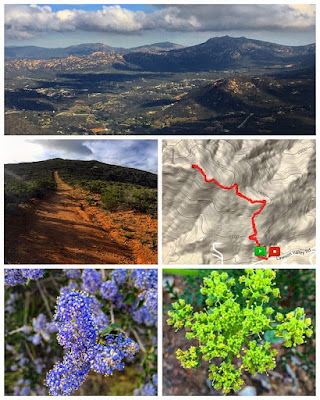52 Hike Challenge 2016 Adventure Series
7.25 miles | +750'
Crest Canyon Open Space Park Preserve is a wonderland of
steep, orange sandstone cliffs and slopes dense with fragrant coastal sage
scrub and southern maritime chaparral.
Lying between Del Mar and Del Mar Hills, Crest Canyon is carpeted
with California buckwheat, bush sunflower, lemonadeberry, prickly-pear cactus,
the bayonet-like yucca, and toyon, also known as California holly, the tree for
which Hollywood was named.
The plant community includes two endangered species. The
magnificent Torrey pine grows only on our North Coast and on Santa Rosa Island
off Ventura. The tiny, delicate succulent, Dudleya brevifolia, produces
star-like, cream-colored blossoms with bright yellow-green centers touched with
red, like flecks of blood.
At orange dawn and dusk, the canyon is alive with birds and
rabbits. The canyon provides a home for the threatened California gnatcatcher
and for the California quail and the California towhee. The canyon is a
stopover on the Pacific Flyway for migrating birds from faraway places.
Crest Canyon originally was included in the plan for Torrey
Pines State Reserve but was omitted because of concerns about cost. The canyon
was badly eroded by increased runoff from the development of the Del Mar Hills
neighborhood in the late 1960s. Crest Canyon was saved from development in the
1970s by local activists who persuaded Del Mar and San Diego to buy and restore
the land for public use.
Most San Diego residents can probably tell you where to find
the rare Torrey Pine, whether or not they realize the tree’s uniqueness. That’s
because the well-known Torrey Pines State Natural Reserve between La Jolla and
Del Mar offers beautiful ocean vistas, secluded hiking, and, of course, plenty
of opportunities to see Torrey pine trees in their natural habitat. Slightly
less famous, but equally worthwhile, is the Torrey Pines State Reserve
Extension, located just across Los Peñasquitos Lagoon from the main reserve.
These less-traveled extension trails offer spectacular pine specimens as well
as a rich collection of other coastal sage scrub and chaparral plant life.
While a stroll through either the main reserve or the
extension may convince you that the magnificent Torrey pine is relatively
abundant, it grows nowhere else in the world except a thin strip of coastline
south of Del Mar and a tiny fragment on Santa Rosa Island of the Channel
Islands. With only a few thousand individuals in the wild, the Torrey pine is
considered rare, threatened, and endangered by the California Native Plant
Society. It is a perfect example of why San Diego is globally known as a
“biodiversity hotspot,” a region with very high numbers of plant and animal
species, particularly endemics, or species that occur nowhere else.
The dry, sandy soils favored by the Torrey pine are also
preferred by a variety of other San Diego natives. This coastal sage scrub
habitat is rich with wildflowers, various shrubs, and, as the name suggests,
sage. Both white and black sage can be found here, as well as the unrelated
(except in smell) California or coastal sagebrush. California poppy and
sunflower bloom here in late winter/early spring, with many additional
wildflowers blooming in the spring months.






















